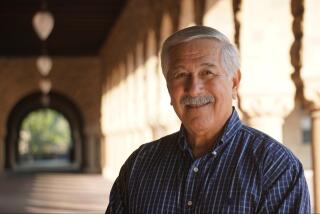Beyond the Barrio, History and Hope
STANFORD — In 25 years, California may find itself in the culturally curious position of having its current majority population as the numerical minority and its minorities--black, Asian and Latino--the majority. “Strange terminology,” Stanford University’s Albert M. Camarillo says, but he believes that demographic prediction for the year 2010 challenges both California public schools and historians like himself.
“It’s too bad if people are scared by that,” Camarillo said. It would be far more positive to realize that California, with its resources and diversity, has an “amazing opportunity for interracial cooperation.”
To capitalize on that opportunity, Camarillo believes schools must instill the richness that different cultures can add to youngsters’ lives. He learned early “to appreciate different cultures and different people” as he grew up first in a small Mexican-American barrio in Compton, then in neighborhoods changing from white to black and Mexican.
Camarillo’s own challenge, as a historian, is to continue to unearth and report on the long California presence of people whose story has often been ignored. “When I was growing up, we studied the ranchos, the romantic Spanish past--never Mexican--and then there was nothing else.” Except for a reference to the Alamo in high school texts, “that was it.” He wants to enlarge the story.
Camarillo, 37, works out of a neat, book-lined office with a restful view of Stanford’s red-tiled roofs, but he is also actively involved in the realities of the public schools.
He has just completed a study of San Jose High School for a joint project of the Stanford School of Education and various Bay Area school districts. Camarillo looked at high school records from 1940 to 1980 to see what worked and what didn’t . “In the late 1960s and early ‘70s at San Jose there was a real turnaround in terms of the orientation of the principal, the staff and likewise the students. They did away with the tracking system; there was no more ability grouping . . . . But more important, there was an attempt to bring cultural and social relevancy into the curriculum, particularly in areas such as English and social studies, things like a course on Mexican literature through the English department, courses on Mexican-American history and culture and other types of courses that were targeted for other minorities.”
The school also provided more counselors who could pay attention to potential dropouts, Camarillo said. But the cut in funds that followed passage of Proposition 13 scuttled the electives, forced layoffs of some of the younger, better teachers and cut the number of counselors from six in 1976 to zero by 1982.
As he looked at achievements of barrio or ghetto youngsters, Camarillo concluded that three things must be in place: family support, some economic stability so students don’t have to drop out to work and guidance from good teachers and counselors. Without these elements, he added, “there’s going to be a whole generation that fails. I think we’re already beginning to see it.”
Camarillo, the first director of Stanford’s Center for Chicano Research, applies his historian’s skills in other ways. His principal scholarly work has been “Chicanos in a Changing Society,” about the evolution of Mexican-Americans from their agrarian world of the mid-1800s into Southern California barrios by 1930. Camarillo is first to admit that readers of the book, published in 1979 by Harvard University Press, “are undergraduates in the four-year universities and my colleagues in the profession; it’s not going to have a great deal of play out there.”
So he condensed his findings into “Chicanos in California,” published by Boyd & Fraser. “It was my effort to provide a broader public audience some Mexican-American history,” he said.
The book attempts to overcome misconceptions that Camarillo says exist because Americans, including journalists, have little sense of history. With much of the recent focus on Mexican-Americans centering on immigration, Camarillo has found some media convey the impression that Mexicans are the latest immigrants and, as such, must wait their turn, when in fact many have been here for years.
Camarillo discovered history was his calling at UCLA, not marine biology--his first major. He also found “it was tough for a young barrio kid to go to West Los Angeles from Compton, a universe away.” He was shocked to find himself one of only 45 Mexican-Americans among 27,000 students in the late 1960s.
But UCLA’s first Mexican-American history course, taught by Juan Gomez-Quinones, changed his perspective. That course “provided a context for the first time in my life to understand the role, the status of Mexican- Americans in American society.”
Camarillo’s books document how Mexicans came early to California but were suppressed when Americans moved in after the Gold Rush. The Americans came with money at a time when the economic base was changing from farming and ranching to industries that needed an unskilled or semiskilled labor force. The Americans also came with prejudices.
“There is a long legacy of Mexican-Anglo relations that have never been very positive. Put those all together, it meant that there was going to be . . . a place for Mexican Americans in this new American society and it was going to be at the bottom. First in the 19th Century they lost their land. Their institutions were overturned so they had no political voice. With the turn of the century, the tremendous new wave of immigrants who came in before the Great Depression, over a million, reinforced how Americans were going to perceive Mexicans. They were poor . . . . Education was not going to be important for these people because, look, they’re supposed to work in the fields, they’re supposed to be menial unskilled workers in factories and in construction.”
Without education, Camarillo adds, people don’t think of themselves as college material, much less professionals: “Schools played a pretty fundamental role in who was going to make it and who was not . . . schools for Mexicans were not designed as a path of social mobility.”
Camarillo lays such stress on education because of what it has meant to him. “Had I not been on a course that was going to put me into the university, I probably would have ended up much like many of my friends. Out of my four best friends--this is an amazing statistic but it’s an indicator of what happens to barrio youth--out of four best friends from childhood, I’m the only one who’s living now. All the rest either died or were killed in drug-related murders, that kind of thing, by the time they were 35. They were never able to break out of that (barrio) condition.”
His own experience underlines his conviction that “if one were to choose certain institutions or certain areas of society that we have to concentrate on to see if they are going to be operating correctly for this growing Hispanic population in our state and other states, education is the key.”
More to Read
Sign up for Essential California
The most important California stories and recommendations in your inbox every morning.
You may occasionally receive promotional content from the Los Angeles Times.










